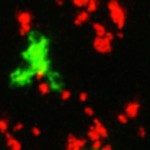Link to Pubmed [PMID] – 7682582
J. Immunol. 1993 May;150(9):3681-9
DBA/2 (H-2d) HLA-B7 x human beta 2-microglobulin transgenic and DBA/2 nontransgenic mice stimulated by DBA/2 HLA-A3 x human beta 2-microglobulin transgenic mouse spleen cells developed potent H-2Kd restricted cytolytic responses with recognition of a peptide from the second domain of the HLA-A3 H chain. These H-2Kd-restricted responses obliterated, as a rule, cytolytic responses with direct recognition of the HLA-A3 molecules, even in HLA-B7 transgenic mice. These immunodominant H-2Kd-restricted responses could be abrogated in DBA/2 HLA-A24 mice because of cross-tolerance, the HLA-A3 derived-H-2Kd presented peptide being shared by several (including A24) HLA class I H chain allelic variants. Under such experimental circumstances, strong CTL responses with exclusive direct recognition of HLA-A3 molecules constantly developed. Further analysis of these responses in six DBA/2 HLA-A24 responder mice indicated that a large fraction of the mouse V beta and V alpha genes could be used to mount such CTL responses. Thus, by combining classical HLA class I transgenesis and selective destruction of H-2K and H-2D genes, it should be possible to derive useful strains of mice for the study of HLA class I-restricted CTL responses.

